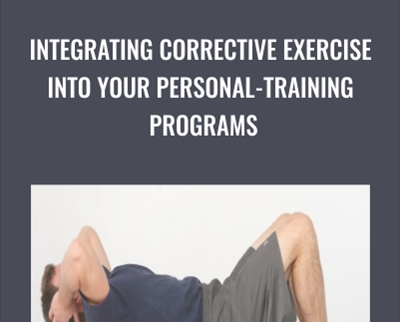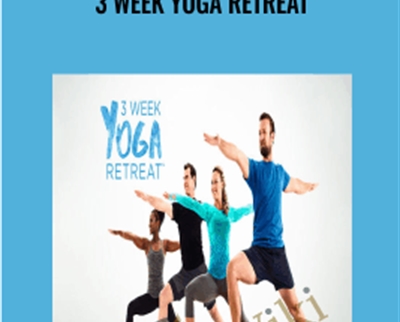Purchase Integrating Corrective Exercise Into Your Personal-training Programs at BoxSkill, You can get access to all files. Direct Download Link and No costs are incurred (No Ads, No Waiting Time, No Capcha).
Not to interrupt your learning, you should download the course after getting the link.
Any well-designed health and fitness program should begin with assessments to help establish baseline measures of your client’s abilities (American Council on Exercise, 2010). The assessment results can then be used to help manipulate program variables to ensure clients are successful in reaching their goal(s). It is easy to incorporate corrective exercise−based assessments into your traditional evaluation procedures. If you are working with a new client, begin your consultation with a verbal assessment to understand your client's health history and any other pertinent information that may be affecting musculoskeletal health (e.g., past injuries, daily activities). Then utilize the visual and hands-on assessments you learned in part one and part two of this three-part series to evaluate the condition of your client’s musculoskeletal system. If you want to integrate corrective exercise strategies with existing clients, simply conduct your assessments as part of their ongoing programming. Conducting the verbal assessments prior to implementing visual and hands-on procedures will help you build trust and rapport with your clients (Rejeski, 1992). It will also help clients feel less anxious about their own situations and more confident in your abilities as a health and fitness professional (Price and Bratcher, 2010).
Introducing Corrective Exercise Strategies
Many clients have aesthetic and performance goals, as well as corrective needs. As such, you may assume they want fitness-based exercises far more than corrective exercise-based ones. However, you will be surprised by how many people actually want help in alleviating aches and pains so they can be better equipped to focus on their primary goals. A great way to introduce corrective exercises to clients is to explain how these exercises can help them reach their fitness objectives faster while also eliminating their pain. Talking with clients about corrective exercise gives you an opportunity to demonstrate your corrective assessments and exercises, and to explain how you can easily integrate such strategies into their program (e.g., as warm-ups, during rest periods or as homework). Making clients aware of your expertise by discussing articles, lectures and/or workshops you have read or attended on corrective exercise and/or biomechanics can also aid you in introducing new exercises and strategies to clients.
When you begin a dialogue about corrective exercise, you’ll be amazed by how many clients reveal information about their individual aches and pains. They may also tell you about others they know who have muscle and joint pain, which may generate new referrals for your business.
Order of Corrective Exercises
All corrective exercise strategies or programs should begin with self-massage or self-myofascial release techniques (Rolf, 1989). Massaging tight or overly worked muscles is akin to chewing a piece of bubblegum before attempting to blow a bubble: You need to loosen the tissues first before you try to stretch and move them; otherwise they could break! Such techniques can be performed with a foam roller, ball or similar massaging device. As tissues become more pliable, you can progress to using various stretching techniques to teach the muscles and joints to go through new ranges of motion (Kendall et al., 2005). As the body begins to accept these new movements, you can ultimately progress your corrective exercise strategies to include strengthening exercises that challenge the body under load/weight and through various planes of motion.
Designing Sessions That Include Corrective Exercise
When incorporating corrective exercises into programs, it is important to select exercises that will have the most impact in alleviating the client’s pain. The results of your musculoskeletal assessments will guide you to make the most appropriate exercise selections. For example, if an assessment reveals that your client has excessive thoracic kyphosis [i.e., an overly rounded upper back; see Thoracic Spine Assessment (page 3)], then a beneficial initial corrective exercise for this person would be a self-myofascial release technique to help recondition the muscles and soft tissues of his or her thoracic spine/upper back [e.g., Foam Roller On Thoracic Spine (page 3)]. You would then progress this client to a stretching exercise for the front of the torso to help promote extension in the thoracic spine [e.g., Step Back With Arm Raise (page 4)]. Finally, you could incorporate an exercise to strengthen the upper-back muscles to aid in pulling the spine upright [e.g., Straight-arm Raise (page 3)]. The foam-roller and stretching exercises could be included as part of the client’s warm-up before working out, and the strengthening exercise could be integrated into the workout as part of a super-set with another upper-body exercise.
To achieve the maximum benefit from corrective exercises, clients must perform them on a regular basis. If necessary, coach your clients to perform corrective exercises for homework. Help them remember what to do by providing written instructions documenting exercise-technique cues, frequency and duration. You can also take pictures of your clients performing their exercise(s) and insert these photos into personalized homework folders. This is a nice way to brand your corrective-exercise services and encourage your clients to adhere to their homework program.
It is also very important to review the recommend corrective exercises with your clients on a regular basis. Reviewing corrective homework exercises enables you to give feedback on client progress or technique and/or answer any questions regarding their experience of the exercise(s). Corrective exercise review also helps you know whether a client has made the improvements needed to progress the program or whether exercise regressions are necessary.
Additional Examples of Corrective Exercises
The five corrective exercises featured in the second article of this series combined with the five exercises described below provide an array of corrective strategies that can be integrated into personal-training programs.
Tennis Ball on GlutesA common musculoskeletal imbalance called excessive lumbar lordosis (see The Importance of Using the Right Assessments) is usually accompanied by an excessive anterior pelvic tilt (i.e., front of pelvis drops and back of pelvis rises up). This imbalance can irritate the muscles of the glutes and posterior hip. This self-massage exercise can help rejuvenate those muscles to enable the hips, pelvis and lumbar spine to function more effectively.
Instruct the client to place a tennis ball under one side of his or her gluteal complex, find a sore spot, and lay on it for 20 to 30 seconds to help it release. Do all sore spots on both sides once per day.
Foam Roller IT Band
Part 2 of this series explained how overly pronated feet cause the lower leg to rotate over the ankle toward the midline of the body. Overpronation pulls on the attachment of the IT band (on the outside of the lower leg) and can irritate this tissue. This self–myofascial release exercise helps recondition the IT band and reduce pain caused by overpronation.
Instruct the client to roll from the side of the leg from the hip all the way down to just above the knee. Perform on both sides for two to three minutes every day.
Glute Stretch
Excessive lumbar lordosis and an anterior pelvic tilt can cause inflexibility of the gluteal complex. This stretching exercise increases the flexibility of the glutes to help allow the hips, pelvis and lumbar spine to move more effectively.
Instruct the client to keep the torso erect, bend and cross one leg over the other and twist the torso to the side while letting the hip drop to the floor on the side being stretched. Hold for 30 seconds on each side, once per day.
Wall Rotation Stretch
Excessive thoracic kyphosis causes immobility of the middle to upper back (i.e., thoracic spine). This exercise helps stretch the muscles that wrap around the torso to help mobilize the thoracic spine and take stress off both the upper and lower back.
Coach the client to stand in a split stance next to a wall and rotate the torso over the leg that is closest to the wall. Ensure that the hips do not shift to the side or let the hip farthest away from the wall rotate with the torso. Hold for 30 seconds on each side, once per day.
Lunge With Knee Pull
Weak gluteal muscles that are unable to help slow down the leg as it rotates over the foot and ankle during weightbearing activities like walking and running can cause overpronation. This exercise helps strengthen the glutes to help take stress off the feet, ankles, knees and lower back.
Instruct the client to do a slight lunge and gently pull the knee toward the midline while rotating the torso over the front leg. Coach the client to keep the spine upright while bending at the hips, knee and ankle. The more the torso is rotated, the more the glutes will activate. Perform six to eight repetitions on each side, three to five times per week.
If a client has trouble performing this exercise, he or she may need to be regressed. Try loosening up his or her glutes more with the “Tennis Ball on Glutes” and then the “Glute Stretch” (see above).
Sample Workout Including Corrective Exercises
Integrating corrective exercises into regular personal-training sessions will help clients address any current pain they have, improve performance and prevent future injury. The following sample personal-training session includes corrective exercise strategies for someone who has overly pronated feet, excessive lumbar lordosis and excessive thoracic kyphosis.
Warm-Up
- Calf Massage (page 2)
- Tennis Ball on Glutes (see above)
- Foam Roller IT Band (see above)
- Foam Roller Thoracic Spine (page 3)
Stretches
- Hip Flexor Stretch (page 3)
- Glute Stretch (see above)
- Step Back With Arm Raise (page 4)
- Wall Rotation Stretch (see above)
Strengthening Program(Possible Super-set Strengthening Routines)
- Standing Shoulder Press
- Straight-arm Raise (page 3)
- Lunge With Knee Pull (see above)
- Squats
- Wood Chops
- Step Back With Arm Raise (with weight in hands) (page 4)
Cool-down
- Repeat: Tennis Ball on Glutes, Foam Roller IT Band, Foam Roller Thoracic Spine,
Hip Flexor Stretch and Glute Stretch
Integrating corrective exercise into personal-training programs is simple, but the effects can be remarkable. Utilizing a structured approach to conducting static or postural assessments and then applying a regimen of self-myofascial, stretching and strengthening exercises to address any imbalances that you uncover can help all of your clients feel great and move even better.
References
American Council on Exercise (2010). ACE Personal Trainer Manual (4th ed.). San Diego, Calif.: American Council on Exercise.
Kendall, F.P. et al. (2005). Muscles Testing and Function with Posture and Pain (5th ed.). Baltimore, Md.: Wolters Kluwer/Lippincott Williams & Wilkins.
Price, J. and Bratcher, M. (2010). The BioMechanics Method (Level One).
Rejeski, W.J. (1992). Motivation for exercise behavior: A critique of theoretical directions. In G.C. Roberts (Ed.), Motivation in Sport and Exercise. Champaign, Ill.: Human Kinetics.
Rolf, I.P. (1989). Rolfing: Reestablishing the Natural Alignment and Structural Integration of the Human Body for Vitality and Well-Being (revised edition). Rochester, Vt.: Healing Arts Press.
Get Integrating Corrective Exercise Into Your Personal-training Programs – Anonymous , Only Price $27
Tag: Integrating Corrective Exercise Into Your Personal-training Programs Review. Integrating Corrective Exercise Into Your Personal-training Programs download. Integrating Corrective Exercise Into Your Personal-training Programs discount.personal training certification personal training gym personal training software personal training studio
Buy the Integrating Corrective Exercise Into Your Personal-training Programs course at the best price at Boxkill. After your purchase, you will get access to the downloads page. You can download all the files associated in your order at here and we will also send a download notification email via your mail.
Unlock your full potential with Integrating Corrective Exercise Into Your Personal-training Programs courses. our courses are designed to help you excel.
Why wait? Take the first step towards greatness by purchasing Integrating Corrective Exercise Into Your Personal-training Programs courses today. We offer a seamless and secure purchasing experience, ensuring your peace of mind. With our trusted payment gateways, Stripe and PayPal, you can confidently complete your transaction knowing that your financial information is protected.
Stripe, known for its robust security measures, provides a safe and reliable payment process. With its encrypted technology, your sensitive data remains confidential throughout the transaction. Rest assured that your purchase is protected.
PayPal, a globally recognized payment platform, offers an additional layer of security. With its buyer protection program, you can feel confident in your purchase. PayPal ensures that your financial details are safeguarded, allowing you to focus on your learning journey.
Is it secure? to Use of?
- Your identity is completely confidential. We do not share your information with anyone. So it is absolutely safe to buy the Integrating Corrective Exercise Into Your Personal-training Programs course.
- 100% Safe Checkout Privateness coverage
- Communication and encryption of sensitive knowledge
- All card numbers are encrypted using AES at relaxation-256 and transmitting card numbers runs in a separate internet hosting atmosphere, and doesn’t share or save any data.
How can this course be delivered?
- After your successful payment this “Integrating Corrective Exercise Into Your Personal-training Programs course”, Most of the products will come to you immediately. But for some products were posted for offer. Please wait for our response, it might take a few hours due to the time zone difference.
- If this happens, please wait. The technical department will process the link shortly after. You will receive notifications directly by e-mail. We appreciate your wait.
What Shipping Methods Are Available?
- You will receive a download link in the invoice or YOUR ACCOUNT.
- The course link always exists. use your account to login and download the Integrating Corrective Exercise Into Your Personal-training Programs course whenever you need.
- You only need to visit a single link, and you can get all the Integrating Corrective Exercise Into Your Personal-training Programs course content at once.
- You can do your learning online. You can be downloaded for better results and can study anywhere on any device. Make sure your system does not sleep during the download.
How Do I Track Order?
- We always notice the status of your order immediately after your payment. After 7 days if there is no download link, the system will automatically complete your money.
- We love to hear from you. Please don’t hesitate to email us with any comments, questions and suggestions.
You must be logged in to post a review.











Reviews
There are no reviews yet.